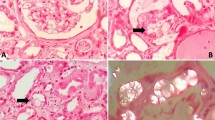Abstract
Analgesic nephropathy is a slowly progressive renal disease, characterised by renal papillary necrosis. Recently, diagnostic criteria for this disease have been defined based on renal computed tomography scanning performed without contrast. The observation of a decreased renal mass of both kidneys, combined with either bumpy contours or papillary calcifications, has been found to have high diagnostic specificity and sensitivity. However, the question remains as to what kind of analgesics can cause analgesic nephropathy.
In the majority of early reports about this condition, phenacetin was singled out as the nephrotoxic culprit. However, during the last decade the nephrotoxic potential of nonphenacetin-containing preparations has become apparent. It is clear that people who abuse analgesics prefer combination analgesics containing 2 analgesics combined with caffeine and/or codeine. In contrast, abuse of products containing only aspirin (acetylsalicylic acid) or paracetamol (acetaminophen) is seldom described and associated renal disease is only occasionally reported.
Experimental evidence of the nephrotoxicity of analgesic preparations is not well established. The results of studies involving analgesic administration in animals remain contradictory.
Clinical evidence linking high consumption of analgesic preparations with analgesic nephropathy is overwhelming. Most patients who admit to over-consuming analgesics have taken preparation containing more than one compound. In recent years, it has become more apparent that preparations not containing phenacetin also have the potential to cause nephrotoxicity manifesting as identical renal lesions. Further epidemiological evidence of the nephrotoxic potential of analgesic combinations has come from case-control studies published during the last decade and from 2 prospective cohort studies.
Effective prevention of analgesic nephropathy consists of the prohibition of over-the-counter sales of preparation containing at least 2 analgesics associated with caffeine and/or codeine.
Similar content being viewed by others
References
Spühler O, Zollinger HU. Die Chronisch-Interstitiëlle Nephritis. Z Klin Med 1953; 151: 1–50
Larsen K, Moller CE. A renal lesion caused by abuse of phenacetin. Acta Med Scand 1959; 164: 53–71
Jacobs LA, Morris JG. Renal papillary necrosis and the abuse of phenacetin. Med J Aust 1962; 2(14): 531–8
Grimlund K. Phenacetin and renal damage at a Swedish factory. Acta Med Scan 1963; 174 Suppl. 405: 1–26
United States Renal Data System. 1993 Annual Data Report. The National Institute of Health, The National Institute of Diabetes and Digestive and Kidney Diseases, Division of Kidney, Urologic and Hematologic Diseases, Bethesda (MD)
Brunner FP, Selwood NH. End-stage renal failure due to analgesic nephropathy, its changing pattern and cardiovascular mortality. Nephrol Dial Transplant 1994; 9: 1371–6
Disney APS. Demography and survival of patients receiving treatment for chronic renal failure in Australia and New Zealand: report on dialysis and renal transplantation treatment from the Australia and New Zealand Dialysis and Transplant Registry. Am J Kidney Dis 1995; 25(1): 165–75
Kincaid-Smith P. Analgesic nephropathy in Australia. Contrib Nephrol 1979; 16: 57–64
Nanra RS. Analgesic nephropathy in the 1990s: an Australian perspective. Kidney Int 1993; 42 Suppl. 44: 86–92
Matousovic K, Elseviers MM, Devecka D, et al. Incidence of analgesic nephropathy among patients undergoing renal replacement therapy in Czech republic and Slovak republic. Nephrol Dial Transplant 1996; 11: 1048–51
Matyus J, Ujhelyi L, Karpati I, et al. Increase in the incidence of analgesic nephropathy in Hungary [letter]. Nephrol Dial Transplant 1997; 12(8): 1774
Perneger TV, Whelton PK, Klag MJ. Risk of kidney failure associated with the use of acetaminophen, aspirin, and nonsteroidal antiinflammatory drugs. N Engl J Med 1994; 331: 1675–9
Sandler DP, Smith JC, Weinberg CR, et al. Analgesic use and chronic renal disease. N Engl J Med 1989; 320: 1238–43
Henrich WL, Agodoa LE, Barrett B, et al. Analgesics and the kidney: summary and recommendations to the scientific advisory board of the National Kidney Foundation from ad hoc committee of the National Kidney Foundation. Am J Kidney Dis 1996; 27(1): 162–5
Rastegar A, Kashgarian M. The clinical spectrum of tubulointerstitial nephritis. Kidney Int 1998; 54: 313–27
Elseviers MM, Bosteels V, Cambier P, et al. Diagnostic criteria of analgesic nephropathy in patients with end-stage renal failure: results of the Belgian study. Nephrol Dial Transplant 1992; 7: 479–86
Elseviers MM, Waller I, Nenov D, et al. Evaluation of diagnostic criteria for analgesic nephropathy in patients with endstage renal failure: results of the ANNE study. Nephrol Dial Transplant 1995; 10: 808–14
De Broe ME, Elseviers MM. Analgesic nephropathy. N Engl J Med 1998; 38: 446–52
Elseviers MM, De Schepper A, Corthouts R, et al. High diagnostic performance of CT scan for analgesic nephropathy in patients with incipient to severe renal failure. Kidney Int 1995; 48: 1316–23
Prescott LF. Analgesic nephropathy: a reassessment of the role of phenacetin and other analgesics. Drugs 1982; 23: 75–149
Murray RM. Genesis of analgesic nephropathy in the United Kingdom. Kidney Int 1978; 13: 50–7
Barrett BJ. Acetaminophen and adverse chronic renal outcomes: an appraisal of the epidemiologic evidence. Am J Kidney Dis 1996; 28(1) Suppl. 1: 14–9
Ferguson I, Johnson F, Reay B, et al. Aspirin, phenacetin, and the kidney — a rheumatism clinic study. Med J Australia 1977; 1: 950–4
Emkey RD, Mills JA. Aspirin and analgesic nephropathy. JAMA 1982; 247: 55–7
Morlans M, Laporte JR, Vidal X, et al. End-stage renal disease and non-narcotic analgesics: a case control study. Br J Clin Pharmacol 1990; 30: 717–23
Segasothy M, Suleimam AB, Puvaneswary M, et al. Paracetamol: a cause for analgesic nephropathy and end-stage renal disease. Nephron 1988; 50: 50–4
Buckalew VM. Habitual use of acetaminophen as a risk factor for chronic renal failure: a comparison with phenacetin. Am J Kidney Dis 1996; 28(1) Suppl. 1: 7–13
Gault MH, Barret BJ. Analgesic nephropathy. Am J Kidney Dis 1998; 32(3): 351–60
De Broe ME, Elseviers MM, Bengtsson U, et al. Analgesic nephropathy. Nephrol Dial Transplant 1996; 11: 2407–8
Porter GA. Acetaminophen/aspirin mixtures: experimental data. Am J Kidney Dis 1996; 28(1) Suppl. 1: 30–3
Nanra RS, Kincaid-Smith P. Experimental evidence for nephrotoxicity of analgesics. In: Stewart JH, editor. Analgesic and NSAID-induced kidney disease. Oxford; Oxford University Press, 1993: 17–31
Duggin GG. Combination analgesic-induced kidney disease: the Australian experience. Am J Kidney Dis 1996; 28 Suppl. 1: 39–47
Schwarz A. Analgesic-associated nephropathy. Klin Wochenschr 1987; 65: 1–16
Raaflaub J, Dubach UC. Dose-dependent change in the pattern of phenacetin metabolism in man and its possible significance in analgesic nephropathy. Klin Wochenschr 1969; 23: 1286–7
Bluemle LW, Goldberg M. Renal accumulation of salicylate and phenacetin: possible mechanisms in the nephropathy of analgesic abuse. J Clin Invest 1968; 47: 2507–14
Schwarz A, Kunzendorf U, Keller F, et al. Progression of renal failure in analgesic-associated nephropathy. Nephron 1989; 53: 244–9
Nanra RS, Stuart-Taylor J, De Leon AH, et al. Analgesic nephropathy: etiology, clinical syndrome, and clinicopathologic correlation in Australia. Kidney Int 1978; 13: 79–92
Murray RM. Analgesic nephropathy: removal of phenacetin from proprietary analgesics. BMJ 1972; 4: 131–2
Elseviers MM, De Broe ME. Wurde das Problem der Analgetika-Nephropathie durch die Entfernung des phenacetins aus analgetischen Mischpräparaten gelöst? Nephrologie 1987; 16: 187–93
Elseviers MM, De Broe ME. Combination analgesic involvement in the pathogenesis of analgesic nephropathy: the European perspective. Am J Kidney Dis 1996; 28 Suppl. 1: 48–55
McCredie M, Stewart JH, Mahony JF. Is phenacetin responsible for analgesic nephropathy in New South Wales? Clin Nephrol 1982; 17(3): 134–40
Murray TG, Stolley PD, Anthony JC, et al. Epidemiologic study of regular analgesic use and end-stage renal disease. Arch Intern Med 1983; 143: 1687–93
Pommer W, Bronder E, Greiser E, et al. Regular analgesic intake and the risk of end-stage renal failure. Am J Nephrol 1989; 9: 403–12
Dubach UC, Rosner B, Pfister E. Epidemiologic study of abuse of analgesics containing phenacetin. Renal morbidity and mortality (1968–1979). N Engl J Med 1983; 308: 357–62
Buckalew VM, Schey HM. Renal disease from habitual antipyretic analgesic consumption: an assessment of the epidemiologic evidence. Medicine 1986; 11: 291–303
Elseviers MM, De Broe ME. A long-term prospective controlled study of analgesic abuse in Belgium. Kidney Int 1995; 48: 1912–9
McLaughlin JK, Lipworth L, Chow W-H, et al. Analgesic use and chronic renal failure: a critcal review of the epidemiologic literature. Kidney Int 1998; 54: 679–86
Elseviers MM, De Broe ME. The implication of analgesics in human kidney disease. In: Stewart JH, editor. Analgesic and NSAID-induced kidney disease. Oxford; Oxford University Press, 1993: 32–47
Author information
Authors and Affiliations
Rights and permissions
About this article
Cite this article
Elseviers, M.M., De Broe, M.E. Analgesic Nephropathy. Drug-Safety 20, 15–24 (1999). https://doi.org/10.2165/00002018-199920010-00003
Published:
Issue Date:
DOI: https://doi.org/10.2165/00002018-199920010-00003




